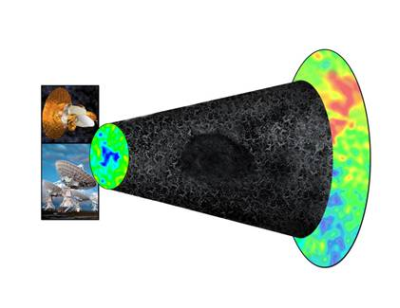28 August 2007

Credit: Bill Saxton, NRAO/AUI/NSF, NASA
Astronomers discovered a vast void in the Universe, nearly one billion light years across, empty of both ordinary visible matter such as stars, galaxies, and nebulae, and the mysterious, invisible "dark matter". Previous studies have revealed holes, or voids, in the large-scale structure of the Universe, but this new discovery is far larger in size.
"Not only has no one ever found a void this big, but we never even expected to find one this size," said Lawrence Rudnick (University of Minnesota). Rudnick and his collaborators report their findings in a paper that is due for publication.
Astronomers have known for years that the large scale structure of the Universe has voids largely empty of matter. However, most of these voids are much smaller than the one found by Rudnick and his colleagues. Furthermore, the number of discovered voids decreases as the size increases.
"What we have found is not normal, based on either observational studies or on computer simulations of the large-scale evolution of the Universe," said Liliya Williams, a coauthor of the article.
The astronomers arrived at their conclusion by studying data from the NRAO VLA Sky Survey (NVSS), a project that imaged the entire sky visible to the Very Large Array (VLA) radio telescope, part of the National Science Foundation's National Radio Astronomy Observatory (NRAO). Their careful study of the NVSS data showed a remarkable drop in the number of galaxies in a region of sky in the constellation Eridanus, the River.
"We already knew there was something different about this spot in the sky," Rudnick said. The void had been dubbed the "WMAP Cold Spot", because it was detected in a map of the Cosmic Microwave Background (CMB) radiation made by the Wilkinson Microwave Anisotopy Probe (WMAP) satellite, launched by NASA in 2001.
The CMB, faint radio waves that are the relic radiation from the Big Bang, is the earliest detectable emission of the Universe. Irregularities in the CMB show structures that existed only about 300,000 years after the Big Bang. (The age of the Universe is estimated to be about 13 billion years old.)
The WMAP satellite measured temperature variations in the CMB that are only millionths of a degree. The cold region in Eridanus was discovered in 2004. Astronomers wondered if the cold spot was intrinsic to the CMB, and thus indicated some structure in the very early Universe, or whether it could be caused by something nearer through which the CMB had to pass on its long journey to Earth. Discovering the scarcity of galaxies in that region by studying NVSS data cracked this cosmic riddle.
"Although our surprising results need independent confirmation, the slightly colder temperature of the CMB in this region appears to be caused by a huge hole devoid of nearly all matter roughly 6billion-10 billion light-years from Earth," said Rudnick.
How does a lack of matter cause a cooler temperature in the CMB as observed from Earth?
Photons (small bundles of electromagnetic energy) of the CMB gain a small amount of energy when they pass through a region of space populated by matter. This effect is caused by the enigmatic "dark energy" that is accelerating the expansion of the Universe. This gain in photon energy makes the CMB appear slightly hotter in that direction. When the photons pass through an empty void, they lose a small amount of energy from this effect, and so the CMB radiation passing through such a region appears cooler.
Dark energy was discovered less than a decade ago. The physical characteristics of dark energy remain unknown, but it is believed to be the most abundant form of energy in the Universe. Revealing its nature is one of the most fundamental topics in astrophysics.
NASA's WMAP satellite, applying microwave amplifiers produced by NRAO's Central Development Laboratory, has yielded valuable information about the age and evolution of the Universe, the emergence of the first stars, and the composition of the Universe. WMAP results have been extensively cited by scientists in various astrophysical research articles.
Further Reading
NRAO
http://www.nrao.edu/
WMAP
http://map.gsfc.nasa.gov/
Aymen Mohamed Ibrahem
Senior Astronomy Specialist